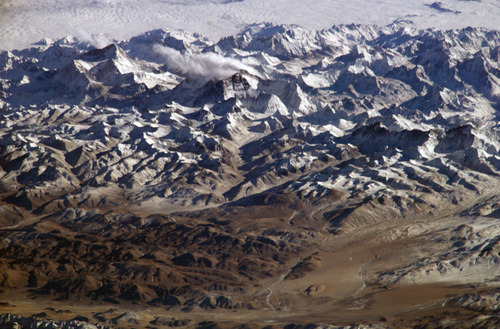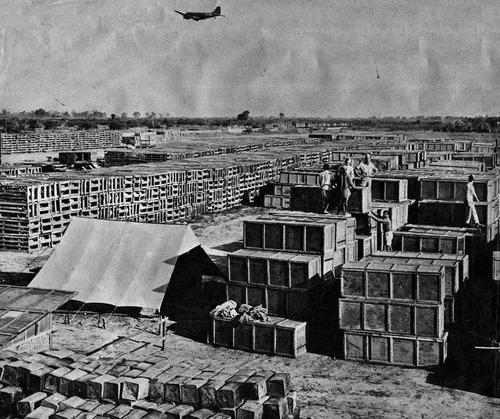The first massive airlift in history
One of the chapters in ‘The Java Gold’ is dedicated to ‘…flying the Hump…’as the ‘air bridge’ into China across the Himalayas soon became known. ‘It was the first massive airlift in history.

The Himalayas as seen after take off from a field in Assam
‘The Hump’ started early in 1942, initially with just a handful of aircrew and airplanes. Most of these planes were hastily ‘converted’ civilian DC-3’s that had been ferried across the Atlantic, Africa and India by a Pan American subsidiary. Often the former civilian owner’s logo and lettering couldstill be seen shining through the hastily applied olive drab army paint.
The US 10th Air Force, ATC and CNAC attempted to carry 10.000 tons of cargo each month into the beleaguered Kunming area that was isolated after the loss of the Burma Road.

Chabua airfield in 1944, with a view of the cargo to be airlifted into China. Gasoline, the square cans in front, had absolute priority!
This had to be done with airplanes that barely had the ceiling to clear some of the ridges they had to cross. With rudimentary navigation aids and unreliable maps. With just a handful of radar stations available and the range of even the most powerful navigational radios reduced to a scant fifty miles. Where they were buffeted by freak winds of up to 250 miles an hour when they attempted to cross between the highest peaks. With turbulences that could flip an aircraft over on its back or force it down thousands of feet in a minute. And if the weather was decent for change, Japanese fighters and even flak were a real threat.

HUMP Route-chart from Assam to China and back…
From May to October the monsoon rains poured down and turned the airfields into sodden bogs. During the hot season all maintenance had to be done at night. Because during the day the planes got so hot that mechanics suffered second degree burns when they touched metal surfaces exposed to the sun. It was hard to get first class mechanics and engineers to work in this place. And the unavoidable faulty maintenance caused so many fatal accidents that
by the end of 1944, the pilots grimly joked that they could navigate between Assam and Kunming following ‘The Aluminum Trail’ of aircraft wrecks that littered the route…

The newspaper for ‘the in-crowd’ at that time
Despite all obstacles, and particularly under the leadership of General Tunner, The Hump turned out to be a success. It’s estimated that from May 1942 to September 1945 some 650,000 tons of cargo and 33,400 personnel were transported in both directions, requiring about 1.5 million flight hours. These figures would not be exceeded until the Berlin Airlift of 1948. General Tunner would lead that operation too, and the principles he established on The Hump to handle massive airlift operations are in use to this day.
However, this success came at a heavy price. A total of 468 US crews and 46 Chinese crews died flying The Hump – more than 1,500 personnel. During some months more than 50% of the planes that departed never made it back.
The casualty rate was at times as bad or even worse than that of the bomber crews of the US Eight Air Force assaulting Germany – but without the publicity and medals that the bomber crews received.

Reblogged this on Pacific Paratrooper and commented:
To honor the men who flew to support the men on the ground….
LikeLiked by 3 people
Thanks for reblogging. And yes, the logistics guys are often forgotten. Let’s honor them.
LikeLiked by 1 person
The only problem I have had reblogging you – is figuring out WHICH post to pick! Very similar to trying to re-blog the IHRA.
LikeLike
That’s a very big compliment. Thank you.
LikeLiked by 1 person
We are certainly over comers aren’t we. The tenacity of the human spirit is incredible. Great post.
LikeLiked by 1 person
Visiting from Pacific Paratrooper.
Thank you for making us think about those who do the grunt work, the hard work, the work that is often taken for granted. The casualty rate was stunning.
LikeLike
Thanks for your comment.
I try to highlight these things because (as you said) these efforts are often taken for granted. I dedicated a whole chapter in my novel to “The Hump”and the appalling conditions under which these men had to live and work and fly. Let’s make sure they’re not forgotten.
Robert
LikeLiked by 1 person
Inspired me to repost my series on father-in-law’s story about running out of fuel and having to bail out on a dark, stormy night into the Burma jungle when he was flying the Hump, G. –Curt
LikeLike
Sounds like a fascinating story Curt – and I noticed that reposting reaches visitors you did not have before. Good luck!
LikeLike
You’ve certainly helped with that Robert, by re-blogging John’s tale. I like to repost on occasion because I have new followers and I believe some of my posts are worth repeating. Thanks. –Curt
LikeLike
Also visiting from Pacific Paratrooper. Great to see this important but all-too-often overlooked part of the war covered.
LikeLike
Thanks!
LikeLike
Reblogged this on Give Me Liberty.
LikeLike
Thanks!
LikeLike
We need to continue to honor these brave men
LikeLike